I started watching pinky violence films of the 60s/70s a few years back and over time built a large collection of DVDs of probably the most popular, and most accessible. The genre is listed as sexploitation, but they’re really just female gang oriented with little content that’s erotic or even erotic-adjacent. Many films in the genre are part of different series, each showcasing the same lead character across films. The DVDs I have include some complete series, but certain entries have been impossible to find. The two I just obtained were this one, the first of four Delinquent Girl Boss (Zubekô banchô) movies, and Girl Boss: Revenge [ 1973 | Wikipedia | IMDB ], the fourth of seven Girl Boss (Sukeban) movies. Somewhat confusing, I know.
This is the 2nd Delinquent Girl Boss film I was able to hunt down. The full series is:
- ✓ Delinquent Girl Boss: Blossoming Night Dreams [ 1970 | IMDB | GCDb ]
- Delinquent Girl Boss: Tokyo Drifters [ 1970 | GCDb ]
- Delinquent Girl Boss: Ballad of Yokohama Hoods [ 1971 | IMDB | GCDb ]
- ✓ Delinquent Girl Boss: Worthless To Confess [ 1971 | IMDB | GCDb ]
(props and $$$ if you can find the other two for me)
(thanks to the internet for most of the images below)
The Delinquent Girl Boss series stars Reiko Oshida as the juvenile delinquent Rika Kageyama. The film begins with her leaving the Akagi detention center and ends with her, and her happy cohorts, returning there. In between she finds a job at a hostess club owned by and employed with ex-“schoolmates” of Akagi. The club owner, Umeko, is harassed by the local Yakuza boss, Ohba, who wants to tear the old building down and rebuild. Having inherited the building from her father (more of that story later), she refuses to give it up. Mob boss harasses plucky ex-cons. You can guess how it ends.
The early scenes with Rika in detention had interesting female prison gang dynamics. Kind of an early, Japanese OitNB? One scene shows the wardens having the girls go through mock weddings in order to know their proper place in society. In these scenes and those right after Rika gets out, there are overtones of women being subjugated by societal norms and rebelling out of anguished frustration. Out of jail, Rika gets a house cleaning job where the husband attacks her. The wife walks in and, though Rika was resisting, Rika is blamed. There is no justice for the dissenting women, especially from other women who are part of “good” society.
Fan service alert: Jailhouse fight in a bath house of topless prisoners.
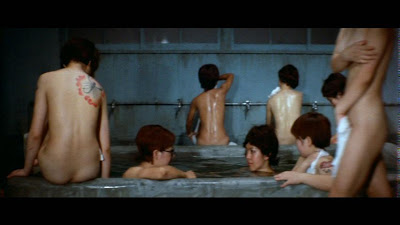
Happily free from her first job (as much tragedy there is in these films, there is an equal expression of unflappability from the heroes) Rika ends up at the famous Shinjuku Station which is filled with hippies and free spirits (“things sure are different now” says the freed criminal, wide-eyed). Here and throughout the movie there are many slapstick scenes with the characters using comedic shorthand (gagging in disgust or lip-licking with desire) or broad wacky characters. The man on the street that tries to pick her up is classic, comedic neophyte lech. Also see: the Yakuza mob boss, a decrepit sugar-daddy, or the transgendered employee of the club (although she becomes endearing and sympathetic, introduced in subtitles as “androgynous/homosexual”, was this transgressive or acceptable or absurd to audiences?).
There are some classic phrases which I have no idea if they’re of the times, culturally unique, or simply provided as absurd humor. In response to being hit on, Rika responds: “Why don’t you wash that face of yours with miso soup.” Huh? Later when ordering at a restaurant: “‘Hamburger medium’? I’ve never heard of that before.” Really?
Rika early on encounters sort of female sub-gangs of the Yakuza. The first group is led by Yacchin: she of the huge, fashion sunglasses. Fashion in this film is 60s crazy and many scenes survive just on the outfits, but for good reason. Rika introduces herself in a manner I had seen in previous pinky films: knees bent, right arm out with an upturned open palm while she–with gravity–recites her history and credentials. I haven’t found any explanation for this, but if someone presents themselves to you like this be sure that she’s a gang member. Anyway: Yacchin and her girls harass Rika but are quickly dispatched (more of that story later).
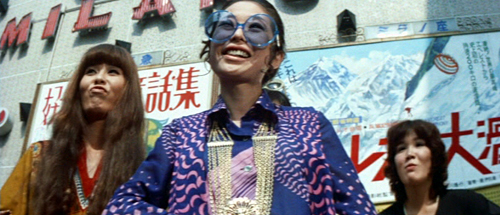
Post Yacchin and her minions, Rika is approached by Tsunao and ends up at the club where he bar tends: Bar Murasaki (one exists in Chicago so when I get back there I’m definitely down for drinks). She goes with him and meets Umeko the owner. When an employee arrives who’s an old friend of hers she finds out that the madame and all employees are ex-“schoolmates” from the Akagi female detention center. Classic.
Fan service alert: Go-go dancing in the club with short skirts and a low camera, if-you-know-what-I-mean.
During are introduction to the club we get a couple of songs a la an Elvis film, a crooning sad song and a bubblegum pop song sung into the camera by three of the dancers. Its lyrics included hilariously odd double-entendres that absolutely had to be written down:
Young girl seems to have sex appeal.
Maybe she doesn’t, maybe she does,
Here’s the yellow cherry.
Try to grab it. One.
Try to suck it. Two.
It’s sweet and sour. Three.
One.
Two.
Three. (sung by an older business man who jumps into the dance sequence)
Yellow cherry.
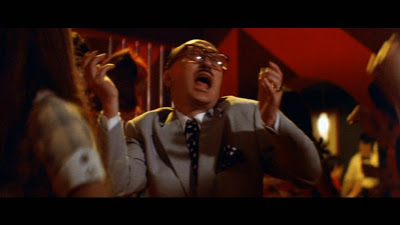
The cast of characters are presented (see my semi-copious list below) in garishly-colored freeze frame with their names, ages, and crimes at the bottom. (Sooo much of the style in this and other pinky films are used by Tarantino in Kill Bill.) Here, also, the Yakuza are introduced:
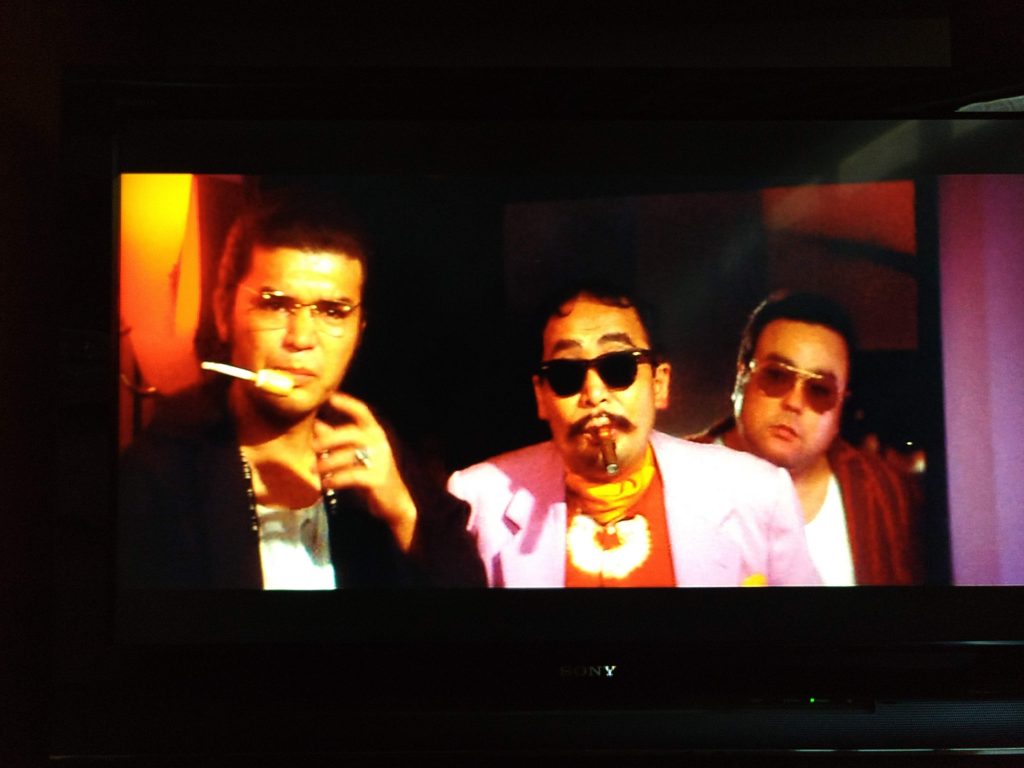
The story and conflict proper proceeds after the Yakuza enter the club. They want Umeko’s building and she won’t sell. The first interaction we see with her and Oharu is telling: she is extremely polite and diplomatic in her deflections of his offers to purchase, he persists, and she ultimately speaks with declarative clarity. Her initial diplomacy as owner, inheritor, madame, and “mother” to her employees broke only when it needed to. This is where the trouble as we know it begins. And this is where we start to understand her backstory. Her love, Shinjiro, was a Yakuza in Ohba’s gang five years ago when, for unknown reasons, he was commanded to kill her father. He went to jail for and two thirds of the way through the film re-appears, freshly released.
There are several other complications with the Ohaba gang throughout the film: Bunny steals drugs from them, flees, gets caught and ultimately dies. One scene has Bunny in a drug den that looked like a monastery populated by characters out of a Fellini film. Mari, her older sister, attempt to kill Ohaba but is also caught. These further put Umeko in debt to the gang.
The movie then lurches along with alternating comic scenes, street fights, melancholy tragedies, and confrontations with the greasy-haired, moustachio-twirling Yakuza boss. In the comic scenes, the actors seem to be having a great time, like an SNL skit.
Harumi, Rika, and Choko in a diner when a copiously wealthy elderly man (“Who’s that wrinkled old fart?”) exits a Bently, down a red carpet, and into the diner where we find out he’s Choko’s sugar-daddy. The others covertly gag in disgust as he paws at Choko and Rika.
Harumi and Rika exit and come upon the second group of female gang, led by Oharu. She and Rika square off in widescreen, western cinema style, each in 60s stylish dresses.
Fan service alert: Yes, they often fall down and I learn that 60s panties were in no way sexy.
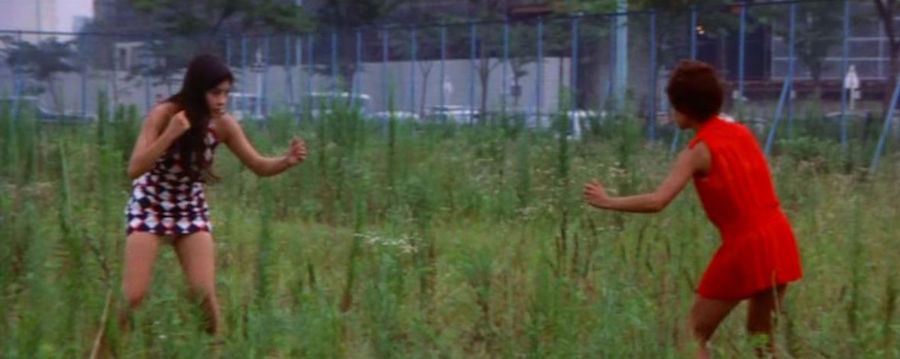
In one of the tragic scenes, Rika gives herself to the greasy Yakuza boss in the hope of freeing Umeko from financial debt with him. After the act he of course double-crosses her. There are a couple other rape or rape-related scenes (see Bunny in captivity above).
Umeko reunites with Shinjiro when she’s at her lowest point, about to give up her club. They somewhat get back together and there is a tragic-love-story standing-in-the-rain-together scene, with somber jazz in the background, and we suspect that he will help her in some way. That some way is the final fight scene with them Samurai-swording their way through the Yakuza gang, then being joined by the plucky ex-cons in a somewhat-violent but mostly-slapstick melee in a pachinko parlor.
They win but Ohba kills Shunjiro and then Umeko kill Ohba. The tragic loss is mitigated by all in a paddy wagon being sent back to prison in happy resignation. Really, really entertaining flick and I can’t imagine how fun it would have been to watch in the theaters when it came out. I need to re-watch the fourth in the series.
Characters
Many characters to keep track of, here they are alpha-ordered:
- Bunny – (blonde) Younger sister to Mari. Addicted to drugs because she had been raped by an Ohba gang member.
- Choko – (looks a little like Rika) Object of the bartender’s affections. They have this weird relationship where he’s supposedly the girls’ pimp.
- Mari Fuyuki, age 21, Nagoya, Charged for inflicting bodily harm – (short, curly auburn hair) The older sister to and protective of Bunny.
- Harumi, androgynous/homosexual from juvenile classification office – Flounces around.
- Rika Kageyama – Our hero, just out of women’s prison!
- Oharu – The leader of one of two female gangs that seem to work for the Ohba gang.
- The Ohba gang – The Yakuza who want to take over the club owned by Umeko Watanabe.
- Mitsuko Senbon (Senmitsu), age 20, Tokyo, Charged with fraud – Lies about everything.
- Shinjiro – Umeko’s lover who went to jail for killing her father 5 years ago. Yakuza who worked for Ohba.
- Tony – Rika’s friend she meets for the first time since they were children. Love interest.
- Tsunao – The goofy bartender who loves Choko.
- Umeko Watanabe, age 26, Charged for inflicting bodily harm – Madam, owner of the club.
- Yacchin – (huge glasses) Leader of the other girl gang.
- Tsuta Yushima (Otsuta), age 23, Fukushima, Charged with theft – (short bob) Angry when she’s drunk.
Trailers included on the DVD:
- Rika 3: Juvenile’s Lullaby – This is from the Rika series about a half-Japanese/half-American.
- Yellow Emmanuel – Looks like low-quality Italian softcore.
- Red Nights of the Gestapo – Wow. Nazi exploitation, but more debased than the Ilse films.
- Porno Holocaust – Double-wow. This looks like just weird porn from the 80s. The director, Joe D’Amato, did five Emanuelle films (including Emanuelle and the Last Cannibals (?!?)), More Sexy Canterbury Tales, Ator 2 (which I saw recently on MST3K and has a wacky production history), and Troll 3, whose history also looks amazing:
Like Troll 2, despite the English title, Troll 3 has no plot connection to the original Troll, features no trolls, and is also a horror film, not a fantasy-comedy. The film has none of the original cast, nor storyline continuation, from either Troll film. In one scene in a bar, a banjo-centric song from Troll 2 can be heard in the background.
D’Amato’s fantasy film Quest for the Mighty Sword was released as Troll 3 in Germany, so these two films have been confused in some reference sources.